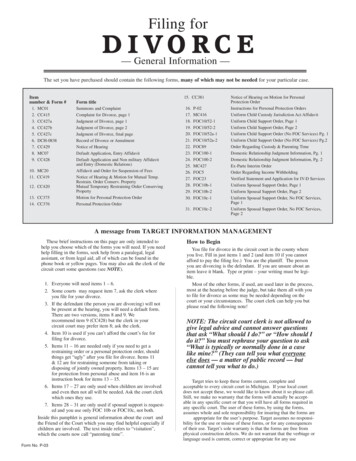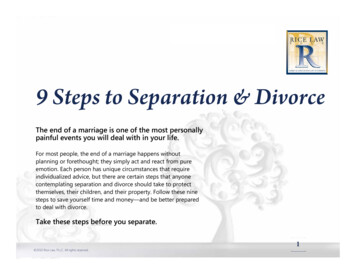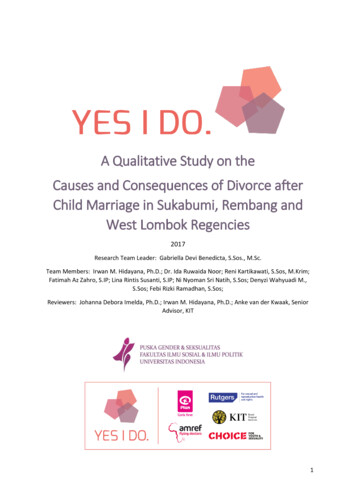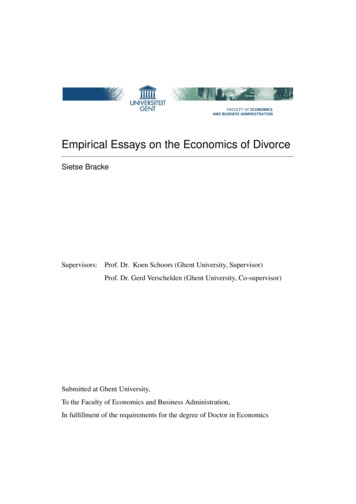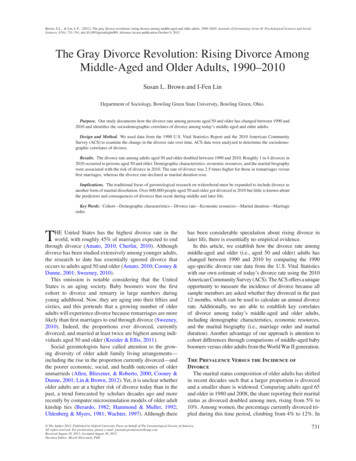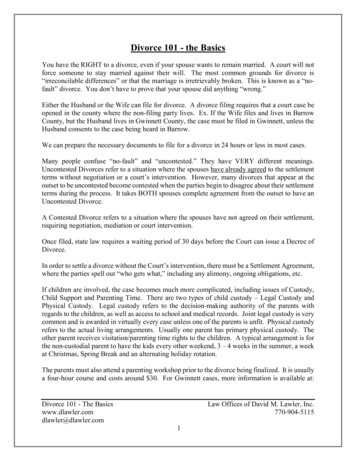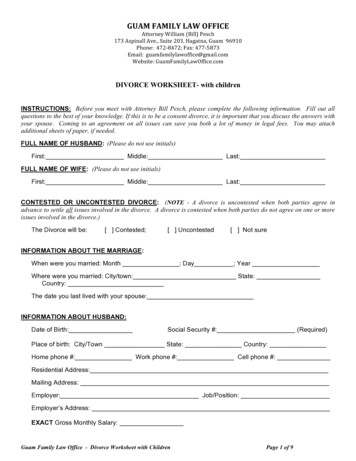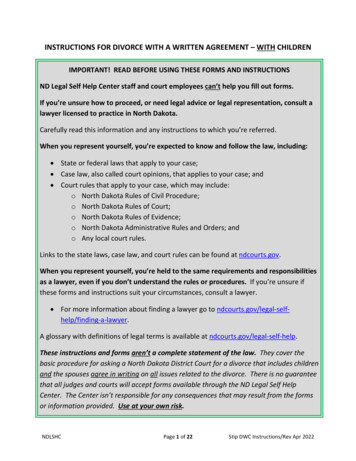
Transcription
INSTRUCTIONS FOR DIVORCE WITH A WRITTEN AGREEMENT – WITH CHILDRENIMPORTANT! READ BEFORE USING THESE FORMS AND INSTRUCTIONSND Legal Self Help Center staff and court employees can’t help you fill out forms.If you’re unsure how to proceed, or need legal advice or legal representation, consult alawyer licensed to practice in North Dakota.Carefully read this information and any instructions to which you’re referred.When you represent yourself, you’re expected to know and follow the law, including: State or federal laws that apply to your case; Case law, also called court opinions, that applies to your case; and Court rules that apply to your case, which may include:o North Dakota Rules of Civil Procedure;o North Dakota Rules of Court;o North Dakota Rules of Evidence;o North Dakota Administrative Rules and Orders; ando Any local court rules.Links to the state laws, case law, and court rules can be found at ndcourts.gov.When you represent yourself, you’re held to the same requirements and responsibilitiesas a lawyer, even if you don’t understand the rules or procedures. If you’re unsure ifthese forms and instructions suit your circumstances, consult a lawyer. For more information about finding a lawyer go to ndcourts.gov/legal-selfhelp/finding-a-lawyer.A glossary with definitions of legal terms is available at ndcourts.gov/legal-self-help.These instructions and forms aren’t a complete statement of the law. They cover thebasic procedure for asking a North Dakota District Court for a divorce that includes childrenand the spouses agree in writing on all issues related to the divorce. There is no guaranteethat all judges and courts will accept forms available through the ND Legal Self HelpCenter. The Center isn’t responsible for any consequences that may result from the formsor information provided. Use at your own risk.NDLSHCPage 1 of 22Stip DWC Instructions/Rev Apr 2022
You may only use these forms if your answer to ALL of the following statementsis “Yes.”1. Both spouses are currently in communication with each other.2. Both spouses agree on all issues. (See Forms 3 and 4 for all issues on which you mustagree.)3. One of the spouses has lived in North Dakota for the past six months.4. All of the minor children have lived in North Dakota with a spouse for at least thepast 6 months (or since birth); *OR* Within the past 6 months, North Dakota wasthe home state of all of the children and one spouse still lives in North Dakota.5. There is no other custody, visitation, divorce, legal separation or paternity orderfrom a North Dakota court or court of another state.6. This is the only legal action pending between the spouses regarding the marriage orthe minor children.7. Neither spouse is currently in the military; *OR* one or both spouses are currently inthe military but not deploying or deployed.8. There is no domestic violence protection order or disorderly conduct restrainingorder currently in effect regarding either spouse.If you answered YES to all of the statements, you may proceed. If you answered NO to anyof the statements in 1 through 8, STOP! You can’t use this set of forms.BEFORE YOU BEGIN – REVIEW FORM 3 AND FORM 4Before you begin the steps for this packet of forms, review the Settlement Agreement(Form 3) and Exhibit A: Confidential Division of Property and Debts and Values (Form 4).Forms 3 and 4 make up the full written agreement for your divorce. If you believe thatyou and your spouse can reach an agreement on every paragraph of Forms 3 and 4,continue.If you don’t believe that you and your spouse can reach an agreement on everyparagraph of Forms 3 and 4, this set of forms may not be suitable.NDLSHCPage 2 of 22Stip DWC Instructions/Rev Apr 2022
FORMS IN THE PACKET:See each individual form for instructions to complete the form.9 FORMS YOU MUST COMPLETE BEFORE FILING WITH THE COURT:Form TitleForm 1: Summons(Plaintiff completes)Form 2: Complaint(Plaintiff completes)Form 3: SettlementAgreement(Plaintiff & Defendantcomplete)DescriptionNotifies the Defendant that the Plaintiff started the process for adivorce. The summons must be signed and dated by the clerk ofcourt to be valid.Gives the court information about the Plaintiff and Defendant,and their children. Tells the court what the Plaintiff is asking forfrom the court.A written and signed agreement of the Plaintiff and Defendantdetermining all issues of the divorce and the parenting rights andresponsibilities to the minor child(ren).Both Plaintiff and Defendant must sign in the presence of anotary public or clerk of court.Form 4: Exhibit A:Confidential Division ofProperty & Debt &ValuesLists the assets and debts of the marriage, as well as the agreedupon values of the assets and outstanding amount of each debt.Divides each asset and debt of the marriage between thespouses.(Plaintiff & Defendantcomplete)Both Plaintiff and Defendant must sign in the presence of anotary public or clerk of court.This form is a part of the court record that isn’t seen by thepublic.Form 5: ConfidentialInformation Form(Plaintiff & Defendantcomplete)Form 6: Admission ofService(Defendant completes)NDLSHCLists the full confidential information that isn’t allowed to appearin other documents filed with the court. This form is a part ofthe court record that isn’t seen by the public.Proof that copies of the completed Form 1: Summons, Form 2:Complaint, and Form 4: Exhibit A: Confidential Division ofProperty & Debt & Values were delivered to and accepted by theDefendant.Page 3 of 22Stip DWC Instructions/Rev Apr 2022
9 FORMS YOU MUST COMPLETE BEFORE FILING WITH THE COURT:Form TitleDescriptionForm 7: Affidavit of Proof The Plaintiff’s written and signed statement of the facts and thefor Stipulated Judgment court’s authority (jurisdiction) to decide the action.(Plaintiff completes)Plaintiff must sign in the presence of a notary public or clerk ofcourt.Form 8: Findings of Fact,Conclusions of Law andOrder for Judgment(Proposed)Findings of Fact are the Court’s written determination of thefacts made from the evidence presented. Conclusions of Law arethe rulings of law made by the Court based on, or in connectionwith, the Findings of Fact. These are your proposed findings offact and conclusions of law, which are based on the SettlementAgreement.(Complete using Form 3)Form 9: Judgment(Proposed)(Complete using Form 3)A written order of the judge’s decision. The divorce isn’t granteduntil the judgment is signed and filed. This is your proposedjudgment, which is based on the Settlement Agreement.1 FORM YOU MUST COMPLETE AFTER THE COURT GRANTS THE DIVORCE:Form TitleForm 10: Notice of Entryof JudgmentDescriptionA required notice from the Plaintiff to the Defendant. Served onthe Defendant within 14 days after the judgment is entered.(Plaintiff completes)ALL OF THE FORMS MUST BE FILLED OUT COMPLETELY BEFORE FILING WITH THE COURT!!Don’t leave any of the paragraphs within the forms unanswered.If a section of the form doesn’t apply to you, type or write “0.00” for the dollar amount, or“N/A” for not applicable.If a form isn’t completely filled out, it could result in the clerk not accepting the forms for filing,or the court may send the form back to you to complete. It could also mean the judge willrequire you to appear in person in court to answer why there are blanks in the form.FOLLOW AND CAREFULLY READ ALL INSTRUCTIONS! There are checkboxes ( ) for yourconvenience. Check each box as you finish the step. Don’t go on to the next step UNTIL theprevious step has been completed.NDLSHCPage 4 of 22Stip DWC Instructions/Rev Apr 2022
IF YOU DON’T MEET THE REQUIREMENTS OF WHO MAY USETHIS PACKET OF FORMSIf your situation doesn’t meet the requirements of who may use this packet of forms, youmay still bring a summary divorce action or a formal contested divorce action to a North DakotaDistrict Court.To see if you meet the requirements for a summary divorce, review the summary divorceinstructions and forms available at ndcourts.gov/legal-self-help/divorce.If you don’t meet the requirements for a summary divorce, review the Contested DivorceInformational Guide available at ndcourts.gov/legal-self-help/divorce. If you decide to represent yourself in a formal contested divorce, you’ll need to createyour own legal documents, or retain an attorney to create the legal documents for you. Examples of many of the legal documents you will need to create are available at theend of the Contested Divorce Informational Guide.WARNINGS!You have the choice to be represented by an attorney of your choice at your own expense. Byusing these forms you are agreeing to expressly waive that right and that you are freely andvoluntarily representing yourself in this action.ND Legal Self Help Center staff and Court personnel can’t help you fill out the form(s) in thispacket.ND Legal Self Help Center staff and Court personnel can’t assist with any questions that requirelegal advice to answer.See a lawyer if you don't know how to answer the questions on these forms or if you think theother spouse will hire a lawyer.As you fill out the form(s) in this packet you must follow the instructions.Type your answers or print neatly using dark ink.Dividing property and real estate is complicated. See a lawyer if you have any questions.There may be tax consequences associated with spousal support or the division of assets. See atax professional if you have any questions.NDLSHCPage 5 of 22Stip DWC Instructions/Rev Apr 2022
CAUTION REGARDING DOMESTIC VIOLENCE.Domestic violence protection orders and disorderly conduct restraining orders generally don’tallow communication between the person protected by the order and the person the order isagainst.This packet of forms is designed to be used by spouses who represent themselves and agreein writing on all issues related to the divorce. The spouses must be in communication witheach other to share information, make decisions and complete the forms before filing with theClerk of Court. If there is a domestic violence protection order or disorderly conduct restrainingorder in effect against either spouse, you can’t use these forms.If there is no domestic violence protection order or disorderly conduct restraining order ineffect, but you’re concerned about the impact of domestic violence on you, this packet of formsmay not be suitable.Before using this packet of forms, you’re strongly urged to consult a lawyer and to contact adomestic violence intervention center in your area to help you navigate your situation.CAWS North Dakota can help you find a domestic violence intervention center in your area.The phone number is (888) 255-6240; the website is cawsnorthdakota.org.NORTH DAKOTA LAWS RELATED TO DIVORCE ANDPARENTING RIGHTS AND RESPONSIBILITIES:Chapter 14-05 of the North Dakota Century Code governs divorce.Chapter 14-09 of the North Dakota Century Code governs parenting rights and responsibilities,such as custody, visitation, and child support.Chapter 14-14.1 of the North Dakota Century Code is the Uniform Child Custody Jurisdictionand Enforcement Act. This Chapter governs when a North Dakota district court has theauthority to make binding decisions on determining parenting rights and responsibilities.Chapter 14-05, 14-09 and 14-14.1 are Chapters within Title 14 of the North Dakota CenturyCode. There are many other laws related to families in Title 14. You may find them of interest.Laws constantly change through legislation, administrative rulings and court decisions. Todetermine how a law applies to your situation, review the applicable law or laws, administrativerulings and court decisions.NDLSHCPage 6 of 22Stip DWC Instructions/Rev Apr 2022
Interpreting what the law means for a specific set of circumstances is a fundamental part oflegal representation. ND Legal Self Help Center staff can’t provide legal representation of anykind under any circumstances. Legal representation can only be provided to you by an attorneywho has agreed to represent you.As a self-represented individual, you perform all of the functions of a lawyer for yourself, whichincludes interpreting what the law means as it applies to your circumstances.To see how the North Dakota Supreme Court has interpreted the laws or rules related todivorce, research North Dakota Supreme Court opinions at ndcourts.gov/supremecourt/opinions. The opinions are case law and are followed by North Dakota courts decidinglater cases with similar facts and issues.You can also find notes of North Dakota Supreme Court opinions related to North Dakota law inthe print editions of the North Dakota Century Code. Print editions of the North Dakota CenturyCode are found in many North Dakota public and academic libraries.DEFINITIONS:***The following definitions are intended to be helpful, BUT they aren’t intended toconstitute legal advice OR address every possible meaning of the terms in this section.***Assets – everything owned by owned by either spouse, whether owned jointly or individually.Assets include, but aren’t limited to, real property, cars, furniture, bank accounts, jewelry, lifeinsurance policies, businesses, and retirement plans.Child Support – payments for the support of a child, including payments for health insurancecoverage or other medical support, and payments for the support of spouses or former spouseswith whom the child is living as long as the spousal support payment is owed to the spouse orformer spouse under the same order as the payments for the child, if the payment is requiredby the order of a court or other governmental agency having authority to issue such orders, andincludes past-due support.Decision making responsibility – the responsibility to make decisions concerning the child. Theterm may refer to decisions on all issues or on specific issues, but not child support issues.Debts – (also called Liabilities) everything owed by either spouse, whether owed jointly orindividually. Debts include, but aren’t limited to, mortgages, credit cards, student loans and carloans.NDLSHCPage 7 of 22Stip DWC Instructions/Rev Apr 2022
Deploying or deployed parent – a deploying or deployed parent is a uniformed service memberwho has been notified of orders of movement or mobilization for more than ninety days butless than eighteen months AND the orders are designated as unaccompanied, not authorizedfor dependent travel, or don’t permit family members to move to the deployment location.Equitable distribution – (also called Equitable Division) marital property is distributed equitably(fairly) in a divorce. A court would make an equitable distribution based on the followingfactors: Respective ages of the spouses;Earning ability;Duration of the marriage and conduct of the spouses during the marriage;Station in life;Circumstances and necessities of the spouses;Health and physical condition;Financial circumstances as shown by the property owned at the time;Value of the property owned at the time;Income-producing capacity of the property owned at the time, if any;Whether the property was accumulated before or after the marriage; andAny other matters that may be material.Generally, the factors above are applied when spouses don’t agree. However, a court has theauthority to decide whether a settlement agreement between the spouses was entered into asa result of mistake, duress, menace, fraud, or undue influence.Home state – the state in which a child lived with a parent for at least six consecutive monthsimmediately before the commencement of a child custody proceeding. In the case of a childless than six months of age, home state means the state in which the child lived from birth witha parent. A period of temporary absence of any of the mentioned persons is part of the period.Irreconcilable differences – (also called No Fault) substantial reasons for not continuing themarriage and which make it appear the marriage should be dissolved. The court need only findthat irreconcilable differences exist.Marital property – all of the assets and debts owned by either spouse, whether owned or owedjointly or individually.Obligor – the person ordered by the court to pay child support or spousal support.Obligee – the person receiving child support or spousal support ordered by the court.NDLSHCPage 8 of 22Stip DWC Instructions/Rev Apr 2022
Parental rights and responsibilities – all the rights and responsibilities a parent has concerningthe parent's child.Parenting plan – a written plan describing each parent's rights and responsibilities.Parenting schedule – the schedule of when the child is in the care of each parent.Parenting time – the time when the child is to be in the care of a parent. (Also known asvisitation.)Personal property – every kind of property that isn’t real property. (See real propertydefinition below.) Personal property includes, but isn’t limited to, cars, furniture, bankaccounts, jewelry, life insurance policies, businesses, and retirement plans.Primary residential responsibility – a parent with more than fifty percent of the residentialresponsibility.Qualified Domestic Relations Order (QDRO) – an order of the court that directs theadministrator of a retirement plan to divide retirement assets as granted in a divorce judgment.There are many different QDRO’s that are specific to the type of retirement plan. For moreinformation about QDRO’s, go to ion-anddivorce and scroll to the “Retirement” section.***If you divide a retirement asset between spouses, a QDRO is required. The spouses MUSTpresent a proposed QDRO to the court to consider and sign. The court WON’T draft a QDRO foryou. The ND Legal Self Help Center DOESN’T have QDRO forms or instructions. Consulting alawyer is strongly recommended when dividing a retirement asset!***Real property – land either with or without buildings upon it. For example, a home is realproperty. (Also known as real estate.)Residency requirement – the amount of time a spouse must live in North Dakota before theycan ask a North Dakota district court to grant a divorce. The residency requirement for NorthDakota is 6 months.Residential responsibility – a parent's responsibility to provide a home for the child. (Alsoknown as custody.)NDLSHCPage 9 of 22Stip DWC Instructions/Rev Apr 2022
THE PARTIES:The spouse starting the divorce action is called the Plaintiff. The other spouse is called theDefendant.The spouse who will be listed as Plaintiff to this divorce action should be a spouse who cananswer “Yes” to Statement #3 on page 2 of these instructions. If neither spouse can answer“Yes” to Statement #3, you may not use this packet of forms.DIVIDING PENSION OR RETIREMENT PLANS:Read this section if the spouses are planning to divide individual pension or retirement plansbetween the spouses.If neither spouse has pension nor retirement plans, OR the spouses will keep their own pensionor retirement plans, without dividing an individual plan, move to STEP ONE.Dividing pension plans and retirement accounts is extremely complicated. The spouses areresponsible for making sure these assets are divided, which will require a separate court orderto divide these assets.The separate court order is called a qualified domestic relations order (QDRO) and the partiesare responsible for obtaining a proposed QDRO and presenting the proposed QDRO to thecourt. The court won’t draft a QDRO document or an order including a QDRO.See STEP FIVE for more information about how to obtain a proposed QDRO before you file thecompleted forms packet with the Clerk of Court.***The ND Legal Self Help Center doesn’t have QDRO forms or instructions and can’t assist withdrafting or obtaining QDRO’s. Consulting a lawyer is strongly recommended when dividing aretirement asset!***(This space left intentionally blank.)NDLSHCPage 10 of 22Stip DWC Instructions/Rev Apr 2022
STEP ONE:Review the Forms and Instructions; Gather Information and Make Decisions Review the forms and instructions:Read these instructions carefully. Review the individual forms and their instructions carefully.Determine if the forms apply to your situation. If you don’t know if you should use this packetof forms, consult a lawyer who is licensed to practice in North Dakota. Gather information and Make Decisions:Both spouses should gather information to help make decisions about the following: Dividing marital property.o Make a list of all assets and debts, including value of each asset and amount ofeach debt.Residential responsibility of the minor child(ren). (Also known as custody.)Parenting time, including scheduling. (Also known as visitation.)Decision making responsibility for the minor child(ren).Child support, including wages and other earnings information.Medical coverage, including health insurance premiums, copays, deductibles, etc. Complete your child support calculations:If you already have a Child Support Order, get a copy of the Order to include with thecompleted packet of forms. You don’t need new child support calculations.If you don’t already have a Child Support Order, you need to complete your child supportcalculations BEFORE either parent signs the Settlement Agreement. If you don’t want toestablish child support at this time, you may not use this packet of forms.WARNING: If you attempt to file this packet of forms without completing the child supportcalculations, the court will either require you to complete the calculations before making adecision on your divorce case, or dismiss your divorce case entirely.The Child Support Division of the North Dakota Department of Human Services created andprovides support for the Child Support Guidelines Calculator. You’ll find the Calculator support-guidelines.You can complete your child support calculations in Excel or on paper. Read and follow theinstructions carefully!NDLSHCPage 11 of 22Stip DWC Instructions/Rev Apr 2022
If the parents will have equal residential responsibility, you must calculate child supportamounts for both parents.If one parent will have primary residential responsibility (more than 50% of the residentialresponsibility), you must calculate the child support amount for the parent with less than 50%of the residential responsibility.WARNING: If you plan to ask the court to allow a parent to pay a different amount of childsupport than the Child Support Guidelines Calculator amount, you’re strongly urged to consulta lawyer for assistance. The Calculator amount is presumed to be the correct amount of childsupport. The parent asking for a deviation from the Calculator amount must prove they meetone of the limited exceptions for deviation, and the deviation is in the best interests of thechild(ren). See North Dakota Century Code Section 14-09-09.7 and North DakotaAdministrative Code Section 75-02-04.1-09.The Child Support Division may be able to provide some assistance with your child supportcalculations. (701-328-5440; 800-231-4255) Court personnel and staff of the ND Legal SelfHelp Center can’t assist with child support calculations.STEP TWO:Fill out the Settlement Agreement (Form 3) and Exhibit A: Confidential Divisionof Property and Debt and Values (Form 4)Both spouses work together to complete these forms. Fill out the Settlement Agreement (Form 3) and the Exhibit A: Confidential Division ofProperty and Debt and Values (Form 4) ONLY if both spouses agree on all issues.The Settlement Agreement (Form 3) and the Exhibit A: Confidential Division of Property andDebt and Values (Form 4) tells the Court that the spouses have reached an agreement settlingall of the issues involved in this divorce action. It also tells the Court exactly what the terms ofthe agreement are.Instructions for completing the Settlement Agreement (Form 3) and the Exhibit A: ConfidentialDivision of Property and Debt and Values (Form 4) are attached to each form.The Settlement Agreement (Form 3) isn’t completed until the date from the completedAdmission of Service (Form 6) is filled in.NDLSHCPage 12 of 22Stip DWC Instructions/Rev Apr 2022
STOP! YOU CAN’T USE THIS SET OF FORMS if both spouses haven’t signed both theSettlement Agreement (Form 3) AND the Confidential Division of Property and Debt andValues (Form 4) in the presence of a notary public or clerk of court. You haven’t reached anagreement on ALL issues.To see other divorce resources available through the ND Legal Self Help Center, go tondcourts.gov/legal-self-help/divorce.(The Exhibit A: Confidential Division of Property and Debts and Values (Form 4) is a confidentialcourt record that isn’t generally available to be viewed by the public after the document is filedwith the clerk of court.However, any person with good cause may make a written request to the court for access to theExhibit A: Confidential Division of Property and Debts and Values (Form 4). If a written request ismade, the person making the request must notify the parties in the divorce. The parties will thenhave the option to tell the court in writing why they agree or disagree with the request.If the court finds that the public interest, or the personal interest of the person making therequest, outweighs the privacy interest of the parties, or their dependent children, the court willgrant access.)STEP THREE:Fill out the Summons (Form 1)The spouse listed as Plaintiff completes this form.The Summons (Form 1) tells your spouse that you have filed a lawsuit against them asking for adivorce, and also tells your spouse that if they do not file a written Answer to your lawsuit, thecourt may give you everything you ask for in your lawsuit. Filling out this form is required eventhough you and your spouse agree to the divorce. Fill out the Summons (Form 1):Instructions for completing the Summons (Form 1) are attached to the form.Go to the Clerk of District Court’s Office and ask the clerk of court to sign and date thesummons.Both parties are required to obey the Summons. Read it carefully!You’ll make copies of the completed Summons (Form 1) in Step 9.NDLSHCPage 13 of 22Stip DWC Instructions/Rev Apr 2022
STEP FOUR:Fill out the Complaint (Form 2)The spouse listed as Plaintiff completes this form.The Complaint (Form 2) is divided into two parts. The first part gives the Court informationabout you, your spouse, and your property. The second part tells the Court and your spousewhat you are asking for from the Court. Filling out this form is required even though you andyour spouse agree to the divorce. Fill out the Complaint (Form 2):Instructions for completing the Complaint (Form 2) are attached to the form.WARNING: By signing your name you’re telling the Court that you’re telling the truth and thatyou have a good faith reason for your requests. If you’re not telling the truth or if you’remisleading the Court of if you’re serving or filing this document for an improper purpose, theCourt could find you in contempt or you may be prosecuted for perjury.You’ll make Copies of Completed Complaint (Form 2) in Step 9.STEP FIVE:Fill out the Confidential Information Form (Form 5)Both spouses work together to complete out this form.Court records are generally available to the public, and anyone can request to look in almostany court file. However, certain information is required to remain confidential, even if it is partof a public court record. Fill out the Confidential Information Form (Form 5):Instructions for completing the Confidential Property is attached to the form.A Note About Confidential Information In Documents Filed with the Court:You and your spouse are solely responsible for making sure confidential information doesn’tappear in the documents you each prepare.NDLSHCPage 14 of 22Stip DWC Instructions/Rev Apr 2022
Confidential information includes: Social security numbersTaxpayer identification numbersBirthdatesFinancial-account numbers.Documents filed with the Court with references to confidential information must include only: The last four (4) digits of the social security number and taxpayer identification numberThe year of birthThe last four (4) digits of the financial-account numberSince the forms in this packet include references to confidential information, you mustprepare a Confidential Information form. The form must contain the full confidentialinformation that is referenced in the documents.You’ll make copies of the completed Confidential Information Form (Form 5) in Step 9.STEP SIX (OPTIONAL):Obtain a Proposed Qualified Domestic Relations Order (QDRO)CAUTION!!Individual Courts may have a Differently Ordered ProcessAND/OR Additional Requirements to the QDRO Process!!The QDRO process is extremely complicated. The information that follows is the basic processfor QDROs. HOWEVER, there are many possible variations to this process.Individual state district courts may require you to follow a differently ordered process thanthe basic process that follows. Individual state district courts may have additional requirementsto those that follow.If you feel you need assistance, consult a lawyer licensed to practice in North Dakota. NDLegal Self Help Center staff CAN’T provide any assistance beyond the information below.NDLSHCPage 15 of 22Stip DWC Instructions/Rev Apr 2022
Dividing pension plans and retirement accounts is extremely complicated. The spouses areresponsible for making sure these assets are divided, which will require a separate court orderto divide these assets. The separate court order is called a qualified domestic relations order(QDRO) and the parties are responsible for obtaining a proposed QDRO and presenting theproposed QDRO to the court. The court won’t draft a QDRO document or an order including aQDRO.Complete this section ONLY if the spouses are dividing individual pension or retirement plansbetween the spouses.If neither spouse has pension nor retirement plans, OR the spouses kept their own pension andretirement plans, without dividing an individual plan, you ma
If your situation doesn't meet the requirements of who may use this packet of forms, you may still bring a summary divorce action or a formal contested divorce action to a North Dakota District Court. To see if you meet the requirements for a summary divorce, review the summary divorce instructions and forms available at
